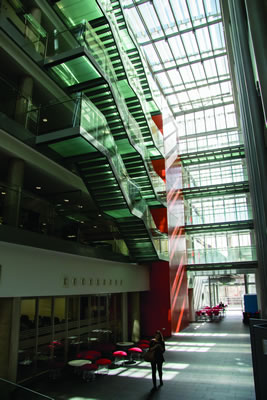
Life Sciences building forms a new landmark on Bristol skyline
In a speech to over 200 guests, staff and students, Sir David said: We in Britain have been leaders in understanding the Life Sciences and you will be the leaders of tomorrow.
Nothing could be more important in the area of scholarship than this. Understanding the natural sciences and the processes that brought us here these things bring joy and resonance and happiness to our lives.
This great building will give you and its graduates pleasure for the rest of your lives. It will play an important role in tackling the great problems and difficulties that the world is going to face in your generation.
The building is the University of Bristol’s biggest construction project to date
The Life Sciences building is the University’s biggest construction project to-date and will be the focal point for globally-leading research, needed to tackle the key challenges of the 21st century such as food security and environmental conservation.
Sir David was shown some of the pioneering research work happening inside the building, and even tried some wasp produce as part of an interactive exhibition. In addition to unveiling a plaque to mark the opening, he also helped to plant a tree in the newly landscaped gardens.
Three years of construction work
Work to construct the 13,500m2 iconic Life Sciences building began in July 2011 and it has just welcomed its first intake of students.
A total of 2,000 people have worked on the project, including 28 architects from ten countries.
Professor Sir Eric Thomas, Vice-Chancellor of the University of Bristol, said: We’re delighted that Sir David has helped us mark this significant milestone in the University’s history.
Many of the most significant advances will come from the Life Sciences and it is fitting that Sir David joined us for the launch of this magnificent building, which will put Bristol on the map for world-renowned research and teaching in this area for years to come.
Sir David Attenborough opened the new building in October
The building, designed by architect Sheppard Robson and built by VINCI Construction UK, forms a new landmark on the Bristol skyline and has a terrace with views across the city.
Patrick Finch, Bursar at the University of Bristol, said: This building and its surrounding public realm has represented the most ambitious project taken on by the University’s Estates Office to-date.
That it has now been successfully handed over to form a wonderful new home for staff and students is a testimony to a strong ethos of team working between staff in Estates and in the School of Biological Sciences, consultants and contractors. I am immensely proud of the team’s achievement, which should set a standard in the sector for many years to come.
BREEAM Excellent rating
This flagship project showcases the best in sustainable design and energy efficiency and it has been designed to achieve the environmental accreditation BREEAM Excellent and represents a major part of the University’s drive to provide energy-efficient laboratories.
Heat from the laboratories’ ventilation systems is reclaimed and re-used; rainwater collected from the roof is used to flush the toilets; blinds lower automatically when the sun shines and lighting has been designed to avoid pollution of the night sky.
Some 2000 people worked on the project including 28 architects from ten countries
To reflect the research being carried out inside, the exterior of the building is home to a striking vertical garden, called a living wall, which stands over 20m above street level. It is home to 11 different species of plant, plus boxes for birds and bats, and creates the pattern of a microscope image of algal cells.
A state-of-the-art greenhouse, known as a GroDome, sits on top of the building and is capable of recreating tropical conditions thanks to controlled light, humidity and temperature.
The Life Sciences building also has one of the largest teaching labs in the country, capable of teaching 200 students at once. There are multiple screens to ensure all students can see, close-up, what the lecturer is doing while moveable walls can change the size of the teaching space.
A five-storey laboratory wing boasts acoustic chambers for bat research, an insectarium, labs for studying ant and bee behaviour, spectroscopy and microscope rooms.
Construction of the Life Sciences building began in July 2011
Peter Cole, Regional Director for VINCI Construction UK, said: The unique facilities within Life Sciences will enhance students’ learning and enable them to be part of a globally-led research and development hub. We are delighted to have been involved with this prestigious project for the University of Bristol and would like to thank all associated with the project for their support in achieving its successful completion.
The space around the building has also been redesigned thanks to Nicholas Pearson Associates, with 21 trees and 3,215m2 of shrubs and grasses.
The development site consists of a 0.9 hectare area on the corner of Tyndalls Avenue and St. Michaels Hill, in the heart of the University’s precinct. Two Grade II listed features of the site were retained the frontage of the former Children’s Hospital and the Ivy Gate which leads to Royal Fort House and gardens, a nationally significant archaeological site having been developed as a bastioned fort during the English Civil war in 1642.
Latest news

29th April 2025
Senior pledges to ‘bee’ part of the solution with new biodiversity initiative
Senior Architectural Systems has installed its first on-site beehive, marking another step forward in its commitment to sustainability and biodiversity.
Posted in Articles, Building Industry News, Building Products & Structures, Building Services, Curtain Walling, Doors, Glass, Glazing, Innovations & New Products, news, Restoration & Refurbishment, Retrofit & Renovation, Sustainability & Energy Efficiency, Walls, Windows
29th April 2025
West Fraser range delivering key benefits for South-East carpentry company
An experienced carpenter and building site manager who has recently set up his own company is using high performance panel products from the West Fraser range.
Posted in Articles, Building Industry News, Building Products & Structures, Building Systems, Case Studies, Garden, Restoration & Refurbishment, Retrofit & Renovation, Sustainability & Energy Efficiency, Timber Buildings and Timber Products
29th April 2025
CPD Courses Available Online From Ecological Building Systems
Ecological Building Systems, a leading supplier of natural building products for sustainable construction, has revealed its comprehensive CPD programme for the year ahead.
Posted in Articles, Building Industry Events, Building Industry News, Building Products & Structures, Building Services, Continuing Professional Development (CPD's), Information Technology, Innovations & New Products, Insulation, Restoration & Refurbishment, Retrofit & Renovation, Seminars, Sustainability & Energy Efficiency, Training, Walls, Waste Management & Recycling
29th April 2025
WindowBASE launches new prospect databases at FIT Show
Visit WindowBASE at the FIT Show to see first-hand how it helps companies find new customers – the company is launching an easy-to-use, intuitive platform on Stand G16 at the NEC Birmingham from 29th April – 1st May.
Posted in Articles, Building Industry Events, Building Industry News, Building Products & Structures, Building Services, Doors, Exhibitions and Conferences, Glass, Glazing, Information Technology, Innovations & New Products, Posts, Publications, Research & Materials Testing, Restoration & Refurbishment, Retrofit & Renovation, Windows
 Sign up:
Sign up: